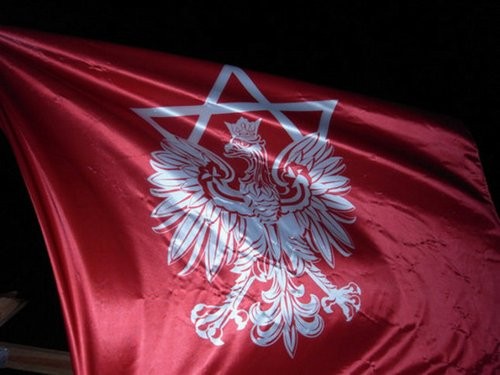Yael Bartana
16 Jan - 28 Feb 2010
YAEL BARTANA
“If you want, we’ll travel to the moon together”
16.01 – 28.02.2010
Annet Gelink Gallery proudly presents its third solo exhibition of Yael Bartana “If you want, we’ll travel to the moon together”. The title is a revealing quote from Mary Koszmary (2007), of which the central work of the exhibition, Mur i Wieża, is the long-awaited successor. This exhibition features the premiere of Mur i Wieża (2009) in the Netherlands.
Mur i Wieża (Wall and Tower) elaborates on the first part of the trilogy, Mary Koszmary (2007). In Mary Koszmary (Nightmares) Polish left activist S⌅awomir Sierakowski (1979) incites in a compelling monologue in an empty stadium in Warsaw 3 million Jews to return to Poland. With in the background the motto ‘3.300.000 Jews can change the life of 40.000.000 Poles’, the works touches upon one of the most essential questions of Polish history – the disastrous results of the Holocaust for Polish society.
Mur i Wieża answers the call of Sierakowski. In the same propagandist style the film shows how a group of young traditionally dressed Jewish pioneers return to Warsaw. At the spot where in World War II the Warsaw Ghetto was located, and beside the impressive ‘Heroes of the Ghetto’ Monument, the cheerfully young people are building a new settlement reminding one of the settlements founded by Jewish colonists in the thirties on Palestinian soil. Yael Bartana hints at the Zionist dream, with heroic images of strong, beautiful men and women building their new country undisturbed by difficult conditions. At the watchtower a blood-red flag with a new symbol has been raised – the Star of David combined with the Polish eagle. Approvingly watched by S⌅awomir Sierakowski, but simultaneously inquiringly looked upon by Polish passers-by.
With this work Yael Bartana rewinds history in a playful manner, strengthened again by the soundtrack. The film is supported by the Polish anthem Mazurek Dąbrowskiego, followed by the Israeli anthem Hatikva, played backwards.
Mur i Wieża cleverly balances on a fine line between fact and fiction. It encourages everyone to critically scrutinize his or her own constructed ideas about migrations and religious-cultural conflicts.
Yael Bartana’s film and video-installations have been included in many international exhibitions over the past years. In December Mur i Wieża had its premiere in the Museum of Modern Art in Warsaw. Other recent exhibitions are amongst others in Kunst-Werke in Berlin and Tate in London, the Contemporary Jewish Museum of San Francisco, the Jewish Museum in New York, P.S.1 in New York, the Museum of Contemporary Art in Tel Aviv and Documenta 12 in Kassel. Her works were also recently included in the leading biennales, such as Contour in Mechelen, the Tirana International Contemporary Art Biennial and Transitland in Sofia, Berlin and Budapest. In 2009 Yael Bartana was awarded the Prix Dazibao in Montreal.
“If you want, we’ll travel to the moon together”
16.01 – 28.02.2010
Annet Gelink Gallery proudly presents its third solo exhibition of Yael Bartana “If you want, we’ll travel to the moon together”. The title is a revealing quote from Mary Koszmary (2007), of which the central work of the exhibition, Mur i Wieża, is the long-awaited successor. This exhibition features the premiere of Mur i Wieża (2009) in the Netherlands.
Mur i Wieża (Wall and Tower) elaborates on the first part of the trilogy, Mary Koszmary (2007). In Mary Koszmary (Nightmares) Polish left activist S⌅awomir Sierakowski (1979) incites in a compelling monologue in an empty stadium in Warsaw 3 million Jews to return to Poland. With in the background the motto ‘3.300.000 Jews can change the life of 40.000.000 Poles’, the works touches upon one of the most essential questions of Polish history – the disastrous results of the Holocaust for Polish society.
Mur i Wieża answers the call of Sierakowski. In the same propagandist style the film shows how a group of young traditionally dressed Jewish pioneers return to Warsaw. At the spot where in World War II the Warsaw Ghetto was located, and beside the impressive ‘Heroes of the Ghetto’ Monument, the cheerfully young people are building a new settlement reminding one of the settlements founded by Jewish colonists in the thirties on Palestinian soil. Yael Bartana hints at the Zionist dream, with heroic images of strong, beautiful men and women building their new country undisturbed by difficult conditions. At the watchtower a blood-red flag with a new symbol has been raised – the Star of David combined with the Polish eagle. Approvingly watched by S⌅awomir Sierakowski, but simultaneously inquiringly looked upon by Polish passers-by.
With this work Yael Bartana rewinds history in a playful manner, strengthened again by the soundtrack. The film is supported by the Polish anthem Mazurek Dąbrowskiego, followed by the Israeli anthem Hatikva, played backwards.
Mur i Wieża cleverly balances on a fine line between fact and fiction. It encourages everyone to critically scrutinize his or her own constructed ideas about migrations and religious-cultural conflicts.
Yael Bartana’s film and video-installations have been included in many international exhibitions over the past years. In December Mur i Wieża had its premiere in the Museum of Modern Art in Warsaw. Other recent exhibitions are amongst others in Kunst-Werke in Berlin and Tate in London, the Contemporary Jewish Museum of San Francisco, the Jewish Museum in New York, P.S.1 in New York, the Museum of Contemporary Art in Tel Aviv and Documenta 12 in Kassel. Her works were also recently included in the leading biennales, such as Contour in Mechelen, the Tirana International Contemporary Art Biennial and Transitland in Sofia, Berlin and Budapest. In 2009 Yael Bartana was awarded the Prix Dazibao in Montreal.

